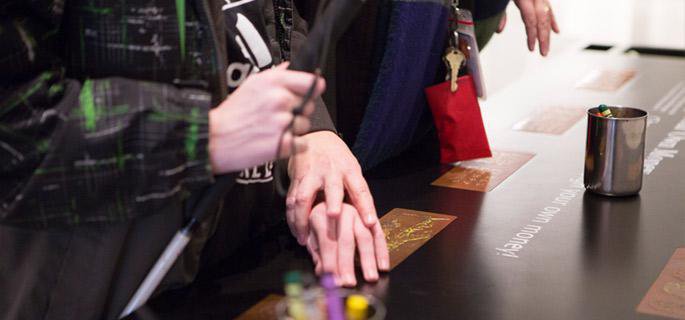When 16-year-old Eliu Andrade visited the Kansas City Money Museum this past December, he enjoyed learning about how the Bank processes money. But Eliu is visually impaired and has difficulty seeing details.
The Money Museum is partnering with the Kansas School for the Blind and other similar institutions to make its space more accessible and enriching to all visitors. Initiatives like customizable tours for special groups, Braille brochures, appropriate signage and tactile experiences are now available, and several other efforts are in the works.
“More accessibility to our museum is a significant goal for the Money Museum,” commented Museum Coordinator Abby Anderson. “We are champions for diversity and inclusion in our workforce, so it’s only natural we develop learning resources with inclusion in mind.”
The new gallery guides in Braille were translated by a specialized local organization, and museum staff is learning and working with the American Sign Language interpreters to provide tours for the hearing impaired.
In addition, the museum went through a professional sensory processing disorder consultation and received great reviews on the lighting and noise levels attesting the museum’s suitability for guests on the autism spectrum.

Most of these efforts are a result of the collaboration and partnership museum staff has established with organizations focused in the development of exemplary programs and practices in vision and hearing and sensitive services in the region, in particularly with the Kansas State Schools for the Deaf and Blind.
“The goal is to develop new strategic alliances to expand the museum resources and ultimately increase the audience,” said Anderson.
During its visit in December, the Kansas State School for the Blind brought a group of 30 students and staff, along with a couple of administrators, including Interim Superintendent Jon Harding.
“It’s crucial for these students to be part of an inclusive society to connect them to real-life experiences: in this case, the value of money and the responsibilities associated with it,” he said.
The school supports students from birth through 21 years of age. The campus offers a comprehensive program with dedicated, licensed specialists to prepare them to assume responsible roles in society and lead fulfilling lives.
“More than ever before, we prepare people with disabilities to live independently and go out to explore places within their communities,” Harding said.
Last year, Anderson participated in a community-partner meeting organized by the school; she had meaningful conversations with people working within the field, expanded her network of accessibility resources and learned a few best practices.
This year, the museum staff is building on the partnership with the schools to continue to incorporate the desires and needs of people with disabilities into their planning and work.
“We’re hosting a workshop in collaboration with the school this upcoming April,” Anderson said. “Educators from the school and others will gather here at the Bank for their annual training and we’ll have an opportunity to ask members how the museum can benefit them as we want to make the Museum a great educational experience for all.”
